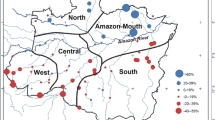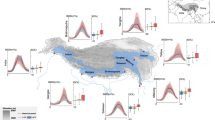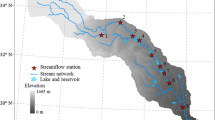Abstract
Reconciling environmental conservation with growing demands for food, water, and energy is a global challenge. Brazil, a major agricultural producer, grapples with deforestation’s environmental costs. The Araguaia River basin, vital for Brazil’s economic growth, undergoes significant land use changes. Assessing data from 1987 to 2019, we studied annual water surface variations, considering deforestation, agriculture, livestock farming land, and central pivot irrigation, and historical water flow series from 1980 to 2020 from 21 monitoring stations. We observed notable reductions in flooded areas (angular coefficients from 130 a 2,276 ha/year) and water flow the entire basin (b = − 13.84; t = − 4.8; P < 0.001) and its regions (Upper Araguaia: b = − 3.32; t = − 4.5; P < 0.001; Middle Araguaia: b = − 8.70; t = − 4.8; P < 0.001; Lower Araguaia: b = − 45.49, t = − 4.7; P < 0.001) over recent years. Water flow reductions persist year-round, with a marked decrease during low water periods (F3,8 = 8.82; P = 0,006), aligning with heightened water demand for intensive agriculture. Tributaries and the main channel show similar reduction processes (t = 0.16; g.l. = 19; P = 0.873). Ensuring the basin’s ecological flow is imperative for the aquatic ecosystem’s minimum requirements.







Similar content being viewed by others
Data availability
All data that we used were obtained in the MapBiomas project (https://mapbiomas.org/)—cumulative annual deforestation and water surface area—and the HidroWeb Portal (https://www.snirh.gov.br/hidroweb/)—historical series of water flow. These raw datasets are available as Supplementary Materials.
References
Aquino, S., J. C. Stevaux & E. M. Latrubesse, 2005. Regime Hidrológico e aspectos do comportamento morfohidráulico do rio Araguaia. Revista Brasileira De Geomorfologia 6: 29–41. https://doi.org/10.20502/rbg.v6i2.49.
Aquino, S., E. M. Latrubesse & E. E. Souza Filho, 2009. Caracterização hidrológica e geomorfológica dos afluentes da bacia hidrográfica do rio Araguaia. Revista Brasileira De Geomorfologia 10: 43–54. https://doi.org/10.20502/rbg.v10i1.116.
Bara, M. K., Y. Velísková & Dulovičová R, Schügerl R, 2014. Influence of surface water level fluctuation and riverbed sediment deposits on groundwater regime. J Hydrol Hydromech 62: 177–185. https://doi.org/10.2478/johh-2014-0030.
Bayer, M., P. C. Assis, T. M. Suizu & M. C. Gomes, 2020. Mudança no uso e cobertura da terra na bacia hidrográfica do rio Araguaia e seus reflexos nos recursos hídricos, o trecho médio do rio Araguaia em Goiás. Revista Confins 48. https://doi.org/10.4000/confins.33972
Booiji, M. J., T. C. Schipper & H. Marhaento, 2019. Attributing Changes in Streamflow to Land Use and Climate Change for 472 Catchments in Australia and the United States. Water 11: 1059. https://doi.org/10.3390/w11051059.
Brown, S., V. L. Versace, L. Laurenson, D. Ierodiaconou, J. Fawcett & S. Salzman, 2012. Assessment of Spatiotemporal Varying Relationships Between Rainfall, Land Cover and Surface Water Area Using Geographically Weighted Regression. Environ. Model Assess 17: 241–254. https://doi.org/10.1007/s10666-011-9289-8.
Bukaveckas, P. A., 2007. Effects of Channel Restoration on Water Velocity, Transient Storage, and Nutrient Uptake in a Channelized Stream. Environ. Sci. Technol 41: 1570–1576. https://doi.org/10.1021/es061618x.
Chen, Y., P. Zhang, Y. Zhao, L. Qu, P. Du & Y. Wang, 2022. Factors Affecting Runoff and Sediment Load Changes in the Wuding River Basin from 1960 to 2020. Hydrology 9: 198. https://doi.org/10.3390/hydrology9110198.
Coe, M. T., M. H. Costa & B. S. Soares-Filho, 2009. The influence of historical and potential future deforestation on the stream flow of the Amazon River-Land surface processes and atmospheric feedbacks. J Hydrol 369: 165–174. https://doi.org/10.1016/j.jhydrol.2009.02.043.
Coe, M. T., E. M. Latrubesse, M. E. Ferreira & M. L. Amsler, 2011. The effects of deforestation and climate variability on the streamflow of the Araguaia River, Brazil. Biogeochemistry 105: 119–131. https://doi.org/10.1007/s10533-011-9582-2.
Coe, M. T., P. M. Brando, L. A. Deegan, M. N. Macedo, C. Neill & D. V. Silvério, 2017. The Forests of the Amazon and Cerrado moderate regional climate and are the key to the future. Trop Conserv Sci 10: 1–6. https://doi.org/10.1177/1940082917720671.
Coelho, M. S., F. M. Resende & G. W. Fernandes, 2013. Chinese economic growth: implications for Brazilian conservation policies. Nat Conserv 11: 88–91. https://doi.org/10.4322/natcon.2013.014.
Easton, Z. M. & A. M. Petrovic, 2004. Fertilizer Source Effect on Ground and Surface Water Quality in Drainage from Turfgrass. J Environ Qual 33: 645–655. https://doi.org/10.2134/jeq2004.6450.
Ferraz, L. L., L. F. Sousa, L. S. da Silva, R. M. de Jesus, C. A. S. Santos & F. A. Rocha, 2022. Land use changes and hydrological trend analysis in a Brazilian Cerrado basin. International Journal of Environmental Science and Technology 19: 7469–7482. https://doi.org/10.1007/s13762-021-03666-8.
Getirana, A., 2016. Extreme water deficit in Brazil detected from space. Journal of Hydrometeorology 17: 591–599. https://doi.org/10.1175/JHM-D-15-0096.1.
Godoy, M. D. P. & L. D. Lacerda, 2014. River-Island Morphological Response to Basin Land-Use Change within the Jaguaribe River Estuary, NE Brazil. Journal of Coastal Research 30: 399–410. https://doi.org/10.2112/JCOASTRES-D-13-00059.1.
Hofmann, G. S., M. F. Cardoso, R. J. V. Alves, E. J. Weber, A. A. Barbosa, P. M. Toledo, F. B. Pontual, L. D. O. Salles, H. Hasenack, J. L. P. Cordeiro, F. E. Aquino & L. F. B. Oliveira, 2021. The Brazilian Cerrado is becoming hotter and drier. Global Change Biology 27: 4060–4073. https://doi.org/10.1111/gcb.15712.
Hurkmans, R. T. W. L., W. Terink, R. Uijlenhoet, E. J. Moors, P. A. Troch & P. H. Verburg, 2009. Effects of land use changes on streamflow generation in the Rhine basin. Water Resour 45: W06405. https://doi.org/10.1029/2008WR007574.
Köppen, W., 1948. Climatologia: con un studio de los climas de la Tierra, Fundo de Cultura Económica, México:
Latrubesse, E. M. & J. C. Stevaux, 2002. Geomorphology and environmental aspects of the Araguaia fluvial basin, Brazil. Zeitschrift Für Geomorphologie 129: 109–127.
Latrubesse, E. M., M. L. Amsler, R. P. Morais & S. Aquino, 2009. The geomorphologic response of a large pristine alluvial river to tremendous deforestation in the South American tropics: The case of the Araguaia River. Geomorphology 113: 239–252. https://doi.org/10.1016/j.geomorph.2009.03.014.
Latrubesse, E. M., E. Arima, M. E. Ferreira, S. H. Nogueira, F. Wittmann, M. S. Dias, F. C. P. Dagosta & M. Bayer, 2019. Fostering water resource governance and conservation in the Brazilian Cerrado biome. Conserv Sci Pract 1: e77. https://doi.org/10.1111/csp2.77.
Le, T., 2023. Increased impact of the El Niño-Southern Oscillation on global vegetation under future warming environment. Scientific Reports 13: 14459. https://doi.org/10.1038/s41598-023-41590-8.
Le, T. & D. H. Bae, 2022. Causal impacts of El Niño-Southern Oscillation on global soil moisture over the period 2015–2100. Earth’s Future. https://doi.org/10.1029/2021EF002522.
Legendre, P. & L. Legendre, 2012. Numerical ecology, Elsevier, Amsterdam:
Lima, L. B., F. Cribari-Neto & D. P. Lima-Júnior, 2022. Dynamic quantile regression for trend analysis of streamflow time series. River Res Applic 38: 1051–1060. https://doi.org/10.1002/rra.3983.
Maneta, M. P., M. Torres, W. W. Wallender, S. Vosti, M. Kirby, L. H. Bassoi & L. N. Rodrigues, 2009. Water demand and flows in the São Francisco River Basin (Brazil) with increased irrigation. Agricultural Water Management 96: 1191–1200. https://doi.org/10.1016/j.agwat.2009.03.008.
Projeto MapBiomas, 2022. Disponível em: https://mapbiomas.org/. Acesso em: 13 ago. 2022.
Moreira, D. C., E. Collicchio & F. B. Gamba, 2019. Panorama do cultivo e produtividade da soja na APA Ilha do Bananal/Cantão, Tocantins: safras 2008/2009. Journal of Bioenergy and Food Science 6: 119–131. https://doi.org/10.18067/jbfs.v6i4.262.
Nearing, M. A., J. R. Simanton, L. D. Norton, S. J. Bulygin & J. Stone, 1999. Soil erosion by surface water flow on a stony, semiarid hillslope. Earth Surf Process Landforms 8: 677–686.
Paredes-Trejo, F., H. A. Barbosa, J. Giovannettone, T. L. Kumar, M. K. Thakur, C. D. O. Buriti & C. Uzcátegui-Briceño, 2021. Drought assessment in the São Francisco River Basin using satellite-based and ground-based indices. Remote Sensing 13: 3921. https://doi.org/10.3390/rs13193921.
Pelicice, F. M., A. A. Agostinho, A. Akama, J. D. A. Filho, V. M. Azevedo-Santos, M. V. M. Barbosa, L. M. Bini, M. G. F. Brito, C. R. A. Candeiro, E. P. Caramaschi, P. Carvalho, R. A. Carvalho, L. Castello, D. B. Chagas, C. C. Chamon, G. R. Colli, V. S. Daga, M. S. Dias, J. A. F. D. Filho, P. Fearnside, W. M. Ferreira, D. A. Z. Garcia, T. K. Krolow, R. F. Kruger, E. M. Latrubesse, D. P. Lima-Júnior, S. F. Lolis, F. A. C. Lopes, R. D. Loyola, A. L. B. Magalhães, A. Malvasio, P. Marco- Júnior, P. R. Martins, R. Mazzoni, J. C. Nabout, M. L. Orsi, A. A. Padial, H. R. Pereira, T. N. A. Pereira, P. B. Perônico, M. Petrere-Júnior, R. T. Pinheiro, E. F. Pires, P. S. Pompeu, T. C. G. Portelinha, E. E. Sano, V. L. M. Santos, P. H. F. Shimabukuro, I. G. Silva, L. B. Souza, F. L. Tejerina-Garro, M. P. C. Telles, F. B. Teresa, S. M. Thomaz, L. H. Tonella, L. G. C. Vieira, J. R. S. Vitule & J. Zuanon, 2021. Large-scale Degradation of the Tocantins-Araguaia River Basin. Environmental Management 68: 445–452. https://doi.org/10.1007/s00267-021-01513-7.
Rosin, C., R. S. S. Amorim & T. S. T. de Morais, 2015. Analysis of hydrological trends in the Rio das Mortes watershed. Revista Brasileira De Recursos Hídricos. 20: 991–998. https://doi.org/10.21168/rbrh.v20n4.p991-998.
Schneider, M., A. A. B. Marques & C. A. Peres, 2021. Brazil’s Next Deforestation Frontiers. Tropical Conservation Science 14: 1–9. https://doi.org/10.1177/19400829211020472.
Silva, A. L. D., S. A. D. Souza, O. Coelho Filho, L. Eloy, Y. B. Salmona & C. J. S. Passos, 2021. Water appropriation on the agricultural frontier in western Bahia and its contribution to streamflow reduction: revisiting the debate in the Brazilian Cerrado. Water 13: 1054. https://doi.org/10.3390/w13081054.
Sousa, L. F., C. A. S. Santos, R. L. Gomes, F. A. Rocha & R. M. Jesus, 2021. Modeling land use change impacts on a tropical river basin in Brazil. International Journal of Environmental Science and Technology 13: 1054. https://doi.org/10.1007/s13762-020-02997-2.
Souza, C. M., J. Z. Shimbo, M. R. Rosa, L. L. Parente, A. A. Alencar, B. F. T. Rudorff, H. Hasenack, M. Matsumoto, L. G. Ferreira, P. W. M. Souza-Filho, S. W. Oliveira, W. F. Rocha, A. V. Fonseca, C. B. Marques, C. G. Diniz, D. Costa, D. Monteiro, E. R. Rosa, E. Vélez-Martin, E. J. Weber, F. E. B. Lenti, F. F. Paternost, F. G. C. Pareyn, J. V. Siqueira, J. L. Vieira, L. C. Ferreira Neto, M. M. Saraiva, M. H. Sales, M. P. G. Salgado, R. Vasconcelos, S. Galano, V. V. Mesquita & T. Azevedo, 2020. Reconstructing Three Decades of Land Use and Land Cover Changes in Brazilian Biomes with Landsat Archive and Earth Engine. Remote Sensing 12: 17. https://doi.org/10.3390/rs12172735.
Spera, S. A., G. L. Galford, M. T. Coe, M. N. Macedo & J. F. Mustard, 2016. Land-use change affects water recycling in Brazil’s last agricultural frontier. Global Change Biology 22: 3405–3413. https://doi.org/10.1111/gcb.13298.
Strassburg, B. B. N., T. Brooks, R. Feltran-Barbieri, A. Iribarren, R. Crouzeilles, R. Loyola, A. E. Latawiec, F. J. B. Oliveira Filho, C. A. M. Scaramuzza, F. R. Scarano, B. Soares-Filho & A. Balmford, 2017. Moment of truth for the Cerrado hotspot. Nat Ecol Evol 1: 3. https://doi.org/10.1038/s41559-017-0099.
Sugianto, S., A. Deli, E. Miswar, M. Rusdi & M. Irham, 2022. The Effect of Land Use and Land Cover Changes on Flood Occurrence in Teunom Watershed. Aceh Jaya Land 11: 1271–1289. https://doi.org/10.3390/land11081271.
Suizu, T. M., E. M. Latrubesse, J. C. Stevaux & M. Bayer, 2022. Planform geometry response of the upper-middle Araguaia River to changes in the hydro-sedimentary regime from 2001 to 2018. Revista Brasileira De Geomorfologia. https://doi.org/10.20502/rbg.v23i2.2088.
Swanson, A. C. & S. Bohlman, 2021. Cumulative impacts of land cover change and dams on the land–water interface of the Tocantins River. Front Environ Sci 9: 662904. https://doi.org/10.3389/fenvs.2021.662904.
Vos, J. & L. Hinojosa, 2016. Virtual water trade and the contestation of hydrosocial territories. Water International 41: 37–53. https://doi.org/10.1080/02508060.2016.1107682.
Weatherhead, E. K. & N. J. K. Howden, 2009. The relationship between land use and surface water resources in the UK. Land Use Policy 26S: S243–S250. https://doi.org/10.1016/j.landusepol.2009.08.007.
Whitman, E., 2019. A land without water. Nature 573: 20–23. https://doi.org/10.1038/d41586-019-02600-w.
Yoon, J., C. Klassert, P. Selby, T. Lachaut, S. Knox, N. Avisse & S. M. Gorelick, 2021. A coupled human–natural system analysis of freshwater security under climate and population change. Proceedings of the National Academy of Sciences 118: e2020431118. https://doi.org/10.1073/pnas.2020431118.
Zar, J. H., 2010. Biostatistical analysis, Pearson Education, London:
Zema, D. A., B. G. Carrà, M. E. Lucas-Borja, P. G. F. Filianoti, P. Pérez-Cutillas & C. Conesa-García, 2022. Modelling Water Flow and Soil Erosion in Mediterranean Headwaters (with or without Check Dams) under Land-Use and Climate Change Scenarios Using SWAT. Water 14: 2338. https://doi.org/10.3390/w14152338.
Acknowledgements
This research was funded in part by the Decanato de Pesquisa e Inovação (DPI) of the University of Brasília (UnB) through the Edital UnB DPI/DPG Nº 03/2021. AST and LCM were supported by Fundação de Apoio à Pesquisa do Distrito Federal (FAPDF) and Coordenação de Aperfeiçoamento de Pessoal de Nível Superior (CAPES) master’s scholarship, respectively. LGCV was supported by Conselho Nacional de Desenvolvimento Científico e Tecnológico (CNPq) research grant.
Funding
Decanato de Pesquisa e Inovação (DPI) of the University of Brasília (UnB), Edital UnB DPI/DPG Nº 03/2021, Carla Albuquerque de Souza
Author information
Authors and Affiliations
Contributions
All authors contributed to the study conception and design. AdST, LCGV, CAdS, LCM and JVEB: Material preparation, data collection and analysis were performed. AdST, LCGV: The first draft of the manuscript was written and all authors commented on previous versions of the manuscript. All authors read and approved the final manuscript.
Corresponding author
Ethics declarations
Conflict of interest
The authors have no relevant financial or non-financial interests to disclose.
Additional information
Handling editor: Koen Martens
Publisher's Note
Springer Nature remains neutral with regard to jurisdictional claims in published maps and institutional affiliations.
Supplementary Information
Below is the link to the electronic supplementary material.
Rights and permissions
Springer Nature or its licensor (e.g. a society or other partner) holds exclusive rights to this article under a publishing agreement with the author(s) or other rightsholder(s); author self-archiving of the accepted manuscript version of this article is solely governed by the terms of such publishing agreement and applicable law.
About this article
Cite this article
dos Santos Teixeira, A., Vieira, L.C.G., de Souza, C.A. et al. Evidence of water surface and flow reduction in the main hydrographic basin of the Brazilian savannah (Cerrado biome): the Araguaia river. Hydrobiologia 851, 2503–2518 (2024). https://doi.org/10.1007/s10750-024-05471-z
Received:
Revised:
Accepted:
Published:
Issue Date:
DOI: https://doi.org/10.1007/s10750-024-05471-z




